check engine MERCEDES-BENZ E-CLASS COUPE 2011 Owners Manual
[x] Cancel search | Manufacturer: MERCEDES-BENZ, Model Year: 2011, Model line: E-CLASS COUPE, Model: MERCEDES-BENZ E-CLASS COUPE 2011Pages: 353, PDF Size: 8.42 MB
Page 8 of 353
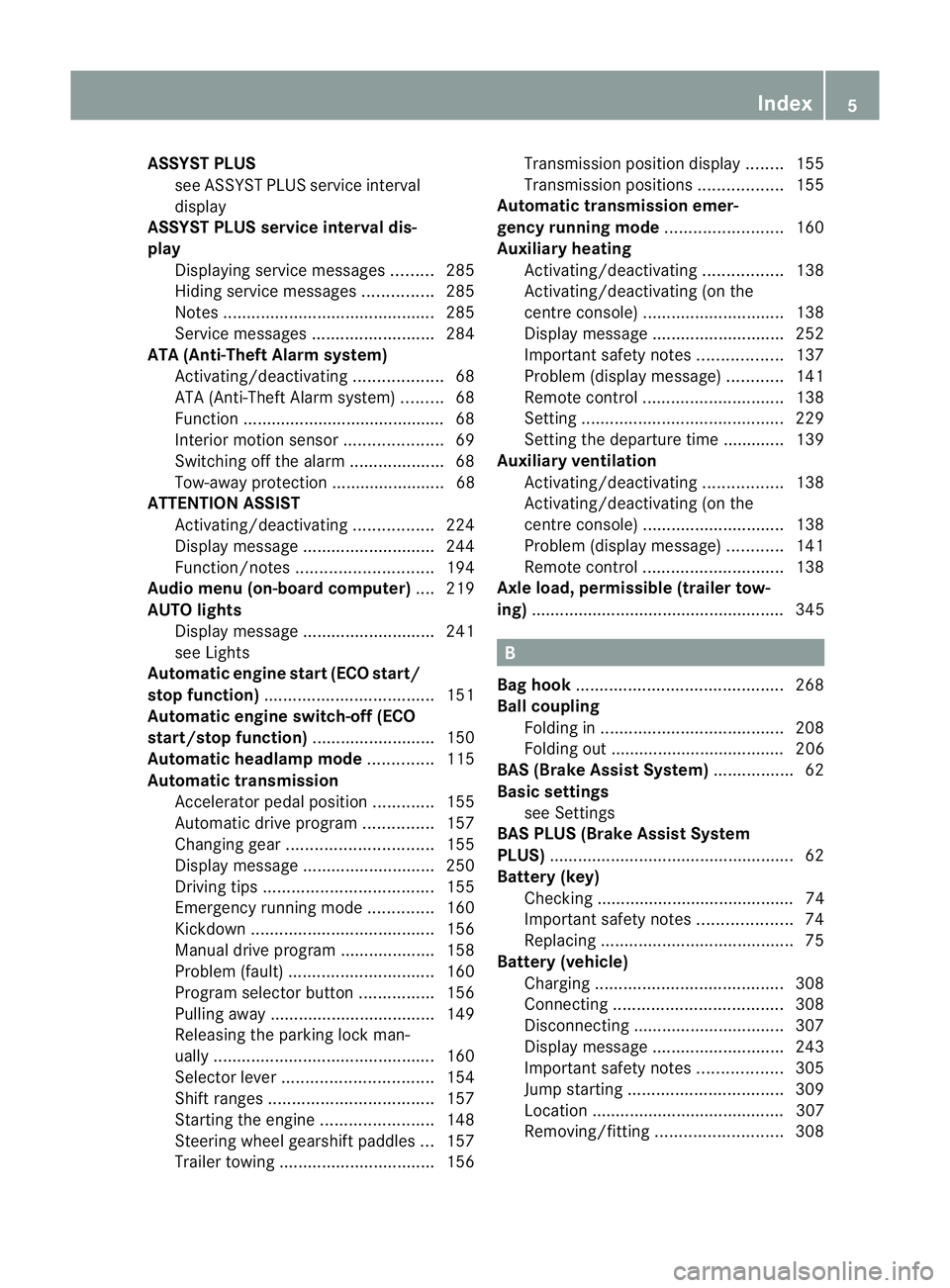
ASSYS
TPLUS
see ASSYS TPLUS service interval
display
ASSYST PLUS servic einterval dis-
play Displaying service messages .........285
Hiding service messages ...............285
Notes ............................................. 285
Service messages ..........................284
ATA (Anti-Theft Alarm system)
Activating/deactivating ...................68
ATA (Anti-Theft Alarm system) .........68
Function .......................................... .68
Interior motion sensor .....................69
Switching off the alarm ....................68
Tow-awa yprotectio n........................ 68
ATTENTIO NASSIST
Activating/deactivating .................224
Display message ............................ 244
Function/notes ............................. 194
Audio menu (on-board computer) ....219
AUTO lights Display message ............................ 241
see Lights
Automatic engine start (ECO start/
stop function) .................................... 151
Automatic engine switch-off (ECO
start/stop function) ..........................150
Automatic headlamp mode ..............115
Automatic transmission Accelerator pedal position .............155
Automatic drive program ...............157
Changing gea r............................... 155
Display message ............................ 250
Driving tips .................................... 155
Emergency running mode ..............160
Kickdow n....................................... 156
Manual drive program ....................158
Problem (fault) ............................... 160
Progra mselecto rbutton ................ 156
Pulling away ................................... 149
Releasing the parking lock man-
ually ............................................... 160
Selector leve r................................ 154
Shift range s................................... 157
Starting the engine ........................148
Steering wheel gearshift paddle s... 157
Trailer towing ................................. 156Transmissio
nposition display ........155
Transmissio npositions .................. 155
Automatic transmission emer-
gency runnin gmode ......................... 160
Auxiliary heating Activating/deactivating .................138
Activating/deactivating (on the
centre console ).............................. 138
Display message ............................ 252
Important safety notes ..................137
Problem (display message) ............141
Remote control .............................. 138
Setting ........................................... 229
Setting the departur etime ............ .139
Auxiliary ventilation
Activating/deactivating .................138
Activating/deactivating (on the
centre console ).............................. 138
Problem (display message) ............141
Remote control .............................. 138
Axl eload, permissible (traile rtow-
ing) ...................................................... 345 B
Ba gh ook ............................................ 268
Ball coupling Folding in ....................................... 208
Folding out ..................................... 206
BAS (Brake Assist System) .................62
Basic settings see Settings
BAS PLU S(Brake Assist System
PLUS) .................................................... 62
Battery (key) Checking .......................................... 74
Important safety notes ....................74
Replacing ......................................... 75
Battery (vehicle)
Charging ........................................ 308
Connecting .................................... 308
Disconnecting ................................ 307
Display message ............................ 243
Important safety notes ..................305
Jump starting ................................. 309
Location ......................................... 307
Removing/fitting ........................... 308 Index
5
Page 10 of 353
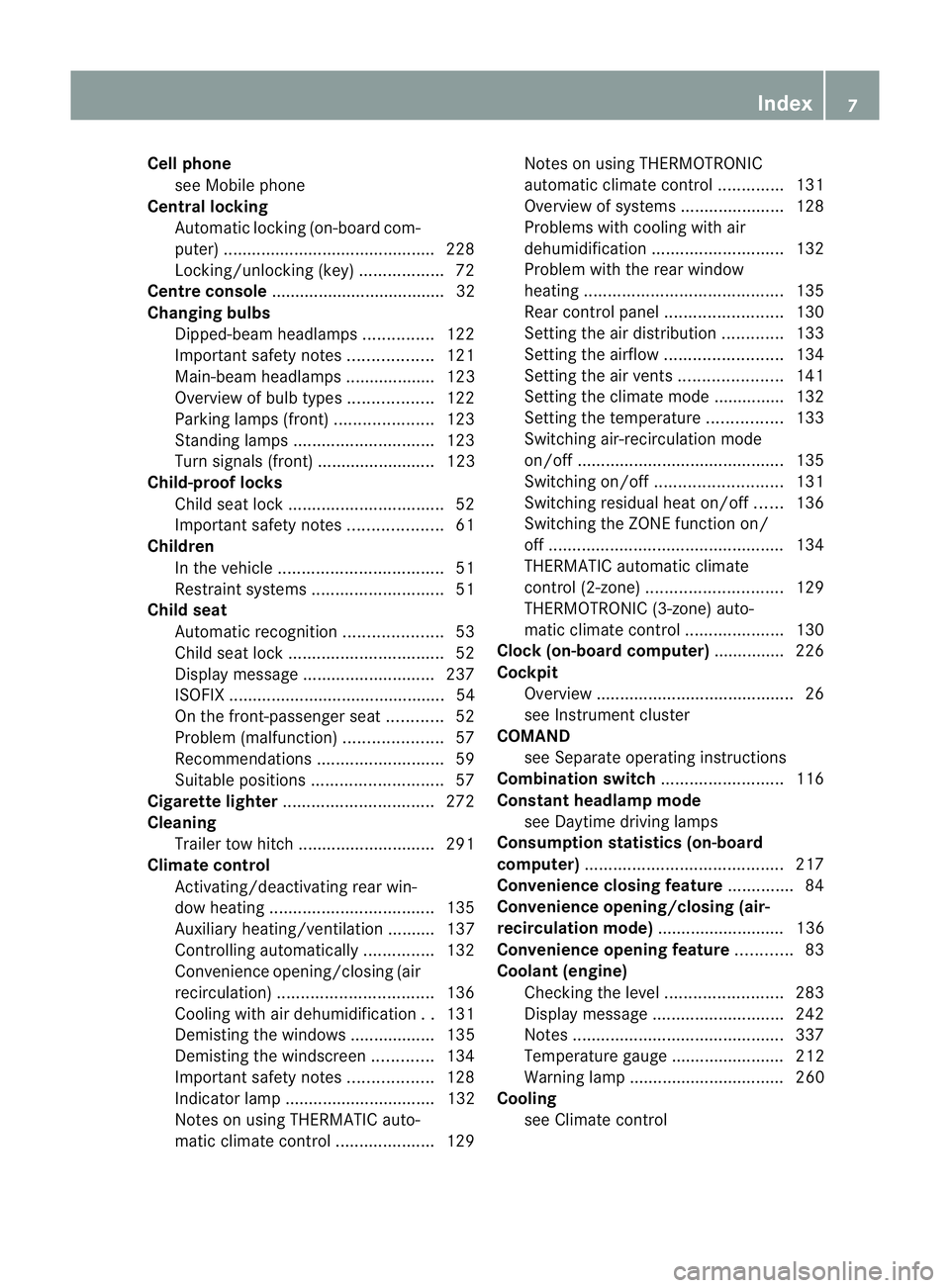
Cell phone
see Mobile phone
Centra llocking
Automatic lockin g(on-board com-
puter) ............................................ .228
Locking/unlocking (key ).................. 72
Centre console ..................................... 32
Changing bulbs Dipped-bea mheadlamps ............... 122
Important safety notes ..................121
Main-beam headlamps ................... 123
Overview of bul btypes .................. 122
Parking lamps (front) .....................123
Standing lamps .............................. 123
Turn signals (front) ......................... 123
Child-proof locks
Child sea tlock ................................. 52
Important safety notes ....................61
Children
In the vehicle ................................... 51
Restraint systems ............................ 51
Child seat
Automatic recognition .....................53
Child sea tlock ................................. 52
Display message ............................ 237
ISOFIX .............................................. 54
On the front-passenger sea t............ 52
Problem (malfunction) .....................57
Recommendations ...........................59
Suitable positions ............................ 57
Cigarette lighter ................................ 272
Cleaning Trailer tow hitch ............................. 291
Climate control
Activating/deactivating rear win-
dow heating ................................... 135
Auxiliary heating/ventilatio n.......... 137
Controlling automatically ...............132
Convenience opening/closing (air
recirculation) ................................. 136
Cooling with aird ehumidification..131
Demisting the windows .................. 135
Demisting the windscree n............. 134
Important safety notes ..................128
Indicator lamp ................................ 132
Notes on using THERMATI Cauto-
matic climate control .....................129Notes on using THERMOTRONIC
automatic climate control
..............131
Overview of systems ......................128
Problems with cooling with air
dehumidification ............................ 132
Problem with the rear window
heating .......................................... 135
Rea rcontrol panel ......................... 130
Setting the aird istribution.............133
Setting the airflow .........................134
Setting the airv ents...................... 141
Setting the climate mode .............. .132
Setting the temperature ................133
Switching air-recirculation mode
on/off ............................................ 135
Switching on/off ........................... 131
Switching residua lheato n/off ......136
Switching the ZONE function on/
off .................................................. 134
THERMATI Cautomatic climate
control (2-zone) ............................. 129
THERMOTRONIC (3-zone) auto-
matic climate control .....................130
Clock( on-board computer) ...............226
Cockpit Overview .......................................... 26
see Instrument cluster
COMAND
see Separate operating instructions
Combination switch ..........................116
Constant headlamp mode see Daytime driving lamps
Consumptio nstatistic s(on -board
computer) .......................................... 217
Convenience closing feature ..............84
Convenience opening/closing (air-
recirculation mode) ........................... 136
Convenience opening feature ............83
Coolan t(engine)
Checkin gthe level ......................... 283
Display message ............................ 242
Notes ............................................. 337
Temperature gauge ........................ 212
Warning lamp ................................. 260
Cooling
see Climate control Index
7
Page 13 of 353
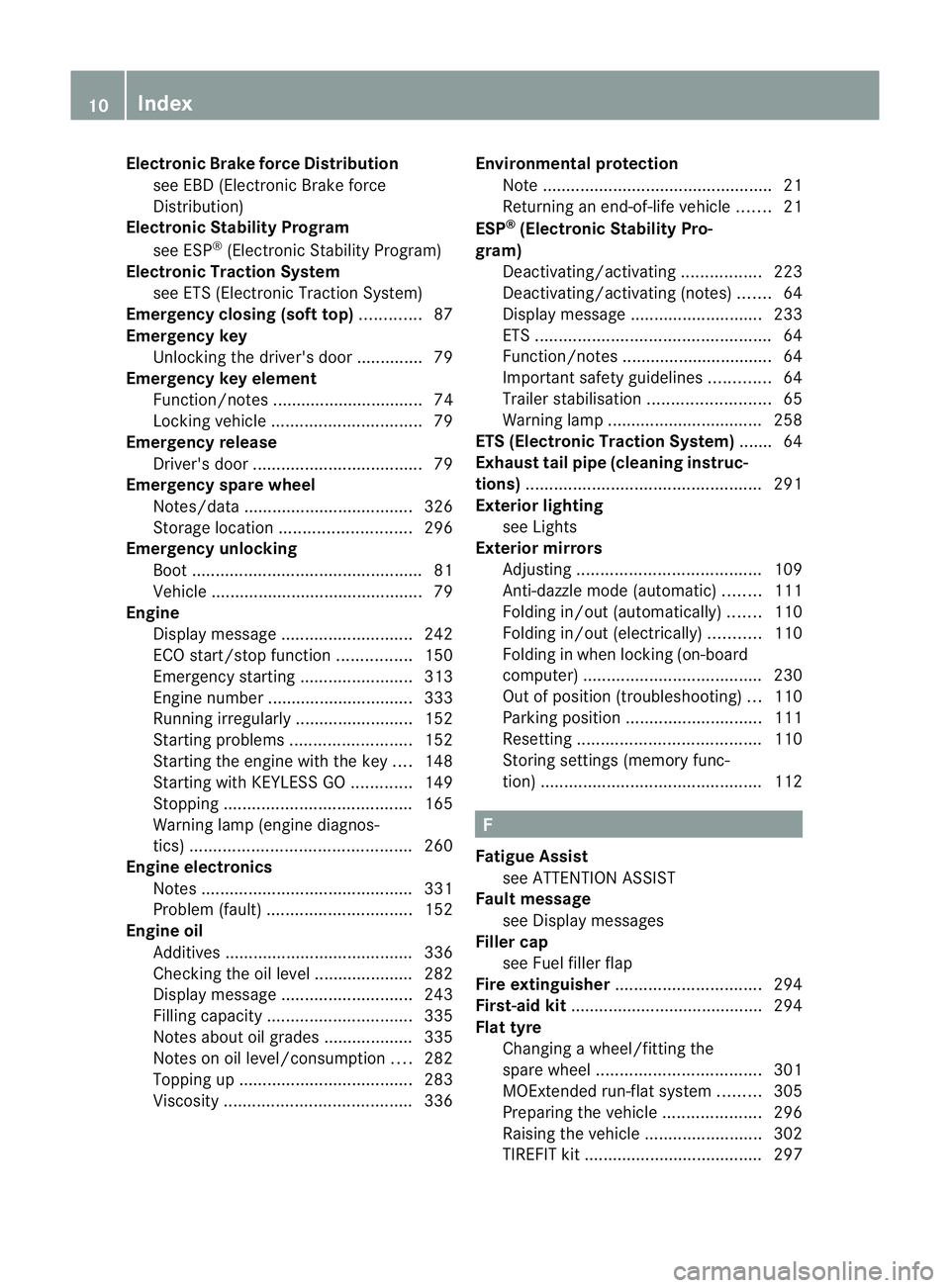
Electronic Brak
eforce Distribution
see EB D(Electronic Brake force
Distribution)
Electronic Stability Program
see ESP ®
(Electronic Stabilit yProgram)
Electronic Traction System
see ET S(Electronic Tractio nSystem)
Emergency closing (soft top) .............87
Emergency key Unlocking the driver's door ..............79
Emergency key element
Function/notes ................................ 74
Locking vehicle ................................ 79
Emergency release
Driver's door .................................... 79
Emergency spare wheel
Notes/data .................................... 326
Storage location ............................ 296
Emergency unlocking
Boot ................................................. 81
Vehicle ............................................. 79
Engine
Display message ............................ 242
ECO start/stop function ................150
Emergency starting ........................313
Engine numbe r............................... 333
Running irregularl y......................... 152
Starting problems ..........................152
Starting the engine with the key ....148
Starting with KEYLESS GO .............149
Stopping ........................................ 165
Warning lamp (engine diagnos-
tics) ............................................... 260
Engine electronics
Notes ............................................. 331
Problem (fault) ............................... 152
Engine oil
Additives ........................................ 336
Checking the oil leve l..................... 282
Display message ............................ 243
Filling capacity ............................... 335
Notes about oil grades ................... 335
Notes on oil level/consumption ....282
Topping up ..................................... 283
Viscosity ........................................ 336Environmental protection
Note ................................................ .21
Returnin ganend-of-life vehicl e....... 21
ESP ®
(Electronic Stability Pro-
gram) Deactivating/activating .................223
Deactivating/activating (notes) .......64
Display message ............................ 233
ETS .................................................. 64
Function/notes ................................ 64
Important safety guidelines .............64
Trailer stabilisatio n.......................... 65
Warning lamp ................................. 258
ETS (Electronic Traction System) ....... 64
Exhaus ttail pipe (cleaning instruc-
tions) .................................................. 291
Exterior lighting see Lights
Exterior mirrors
Adjusting ....................................... 109
Anti-dazzle mode (automatic) ........111
Folding in/ou t(automatically) .......110
Folding in/ou t(electrically) ...........110
Folding in whe nlocking( on-board
computer) ...................................... 230
Out of position (troubleshooting) ...110
Parking position ............................. 111
Resetting ....................................... 110
Storing settings (memory func-
tion) ............................................... 112 F
Fatigue Assist see ATTENTION ASSIST
Faul tmessage
see Display messages
Filler cap
see Fuel filler flap
Fire extinguisher ............................... 294
First-aid kit ......................................... 294
Flat tyre Changing awheel/fitting the
spare wheel ................................... 301
MOExtended run-fla tsystem ......... 305
Preparing the vehicle .....................296
Raising the vehicle .........................302
TIREFIT kit ...................................... 297 10
Index
Page 15 of 353
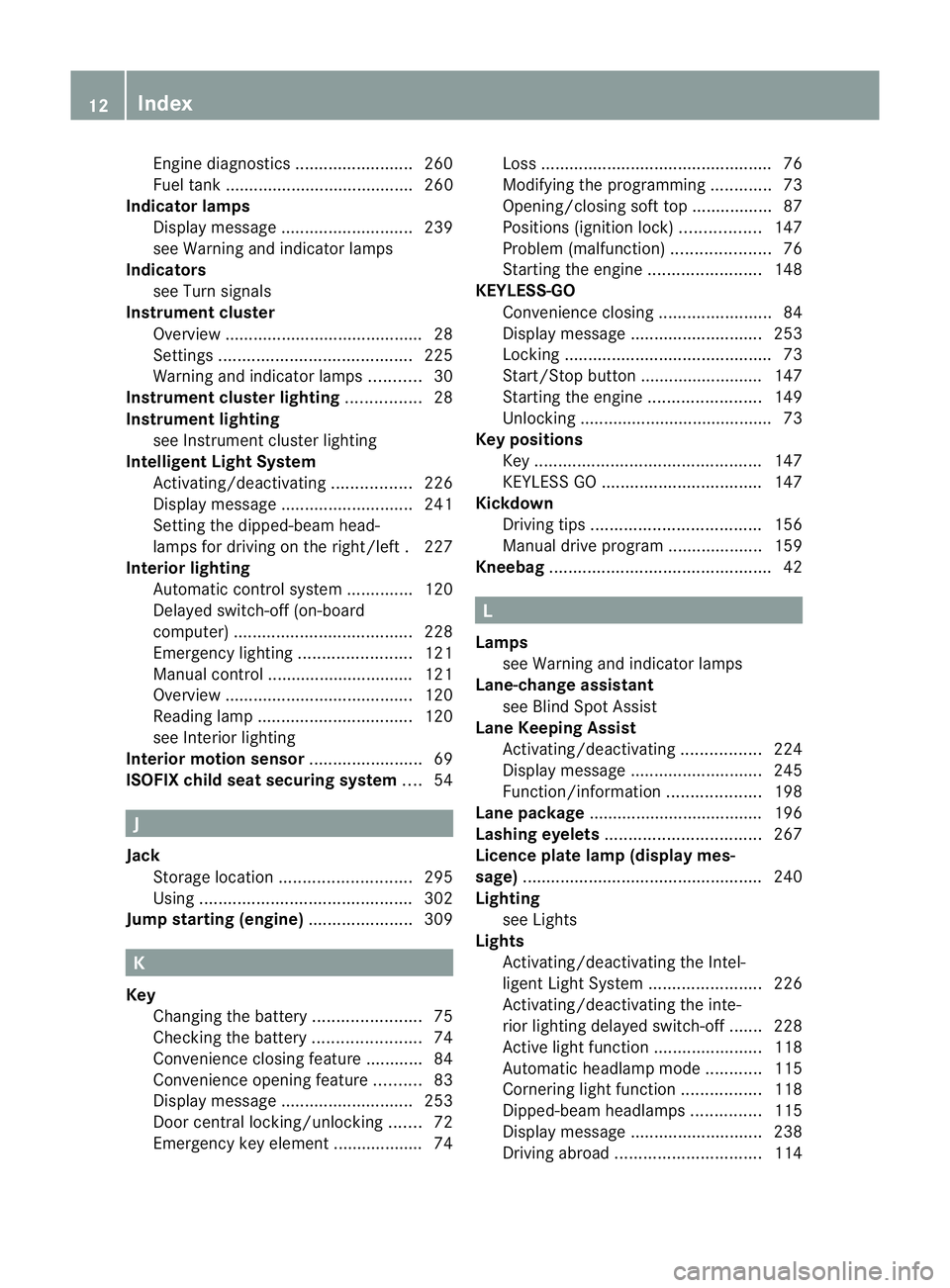
Engine diagnostics
.........................260
Fuel tank ........................................ 260
Indicator lamps
Display message ............................ 239
see Warning and indicator lamps
Indicators
see Turn signals
Instrument cluster
Overview .......................................... 28
Settings ......................................... 225
Warning and indicator lamps ...........30
Instrument cluster lighting ................28
Instrument lighting see Instrument cluster lighting
Intelligen tLight System
Activating/deactivatin g................. 226
Display message ............................ 241
Setting the dipped-bea mhead-
lamps for driving on the right/left .227
Interior lighting
Automatic control system ..............120
Delayeds witch-off (on-board
computer) ...................................... 228
Emergency lighting ........................121
Manual control ............................... 121
Overview ........................................ 120
Reading lamp ................................. 120
see Interior lighting
Interior motio nsensor ........................ 69
ISOFIXc hild seat securing system ....54 J
Jack Storage location ............................ 295
Using ............................................. 302
Jump starting (engine) ......................309 K
Key Changing the battery .......................75
Checking the battery .......................74
Convenience closing feature ............84
Convenience opening feature ..........83
Display message ............................ 253
Door central locking/unlocking .......72
Emergency key element ................... 74 Loss
................................................. 76
Modifying the programming .............73
Opening/closing soft top .................87
Positions (ignition lock) .................147
Problem (malfunction) .....................76
Starting the engine ........................148
KEYLESS-GO
Convenience closing ........................84
Display message ............................ 253
Locking ............................................ 73
Start/Stop button .......................... 147
Starting the engine ........................149
Unlocking ......................................... 73
Keyp ositions
Key ................................................ 147
KEYLESS GO .................................. 147
Kickdown
Driving tips .................................... 156
Manual drive program ....................159
Kneebag ............................................... 42 L
Lamps see Warning and indicator lamps
Lane-chang eassistant
see Blind Spot Assist
Lane Keepin gAssist
Activating/deactivating .................224
Display message ............................ 245
Function/informatio n.................... 198
Lane package ..................................... 196
Lashing eyelets ................................. 267
Licenc eplate lamp (display mes-
sage) ................................................... 240
Lighting see Lights
Lights
Activating/deactivating the Intel-
ligent Ligh tSystem ........................ 226
Activating/deactivating the inte-
rior lighting delayed switch-off .......228
Active light function .......................118
Automatic headlamp mode ............115
Cornering light function .................118
Dipped-bea mheadlamps ............... 115
Display message ............................ 238
Driving abroad ............................... 11412
Index
Page 42 of 353
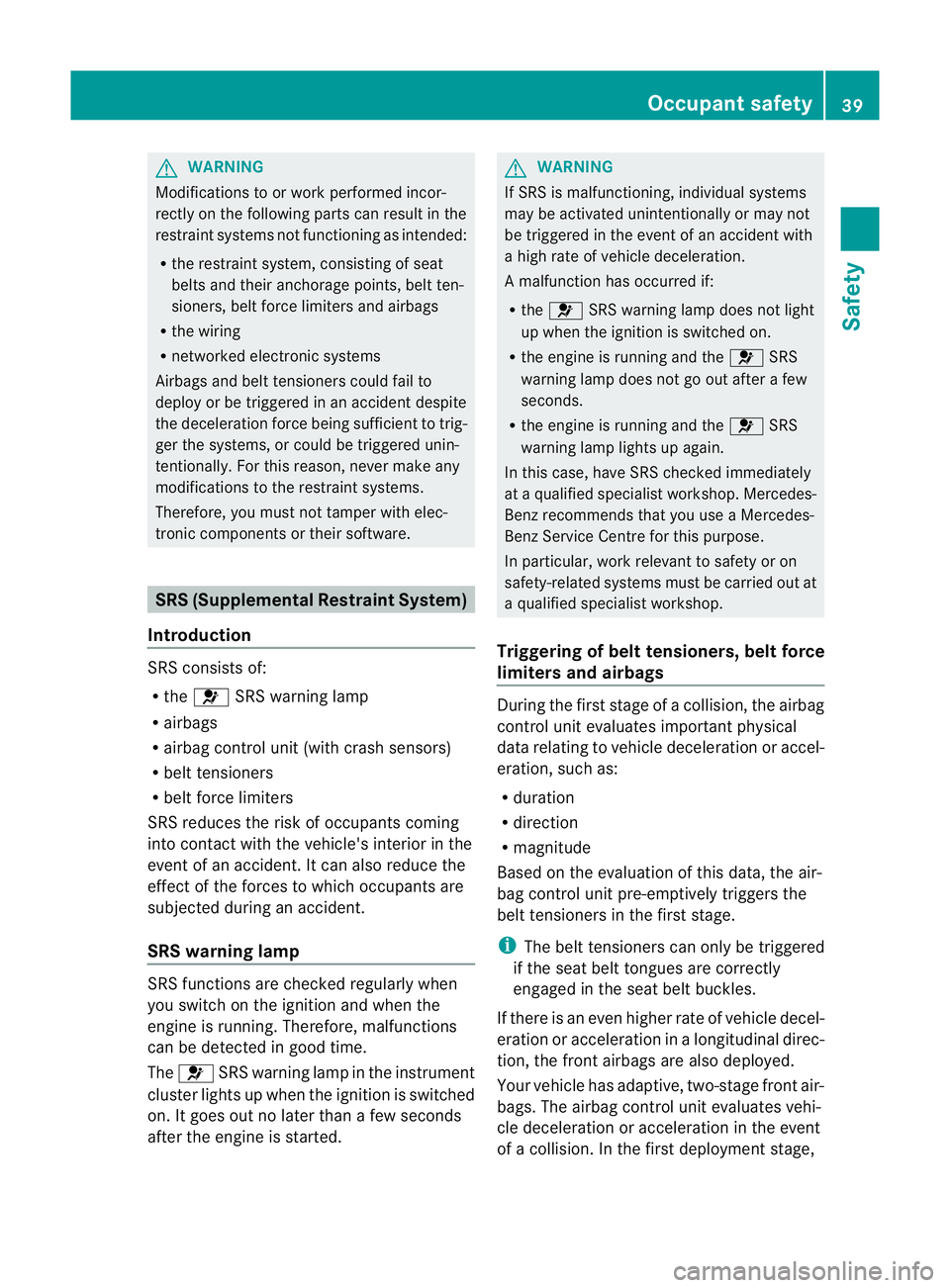
G
WARNING
Modifications to or work performe dincor-
rectly on the following parts can result in the
restraint systems not functioning as intended:
R the restraint system, consisting of seat
belts and their anchorage points, beltt en-
sioners, belt forc elimiters and airbags
R the wiring
R networked electronic systems
Airbags and belt tensioners could fail to
deploy or be triggered in an acciden tdespite
the deceleration forc ebeing sufficien ttotrig-
ger the systems, or could be triggered unin-
tentionally. For this reason, never make any
modifications to the restraint systems.
Therefore, you must not tamper with elec-
tronic components or their software. SRS (Supplemental Restraint System)
Introduction SRS consist
sof:
R the 6 SRS warning lamp
R airbags
R airbag control unit (with crash sensors)
R belt tensioners
R belt force limiters
SRS reduces the risk of occupant scoming
into contact with the vehicle's interior in the
event of an accident .Itcan also reduce the
effect of the forces to which occupant sare
subjected during an accident.
SRS warning lamp SRS functions are checked regularly when
you switch on the ignition and when the
engine is running. Therefore, malfunctions
can be detected in good time.
The 6 SRS warning lamp in the instrument
cluster lights up when the ignition is switched
on. It goes out no later than afew seconds
after the engine is started. G
WARNING
If SRS is malfunctioning, individual systems
may be activated unintentionally or may not
be triggered in the event of an accident with
ah igh rate of vehicle deceleration.
Am alfunction has occurred if:
R the 6 SRS warning lamp does not light
up when the ignition is switched on.
R the engine is runnin gand the 6SRS
warning lamp does not go out after afew
seconds.
R the engine is runnin gand the 6SRS
warning lamp lights up again.
In this case, have SRS checked immediately
at aq ualified specialist workshop. Mercedes-
Benz recommends that you use aMercedes-
Benz Service Centre for this purpose.
In particular, work relevant to safety or on
safety-related systems must be carried out at
aq ualified specialist workshop.
Triggering of belt tensioners, belt force
limiters and airbags During the first stage of
acollision, the airbag
control unit evaluates important physical
data relating to vehicle deceleration or accel-
eration, such as:
R duration
R direction
R magnitude
Based on the evaluation of this data, the air-
bag control unit pre-emptively triggers the
belt tensioners in the first stage.
i The belt tensioners can only be triggered
if the seat belt tongues are correctly
engaged in the seat belt buckles.
If there is an even higher rate of vehicle decel-
eration or acceleration in alongitudinal direc-
tion, the front airbags are also deployed.
Your vehicle has adaptive, two-stage front air-
bags. The airbag control unit evaluates vehi-
cle deceleration or acceleration in the event
of ac ollision. In the first deployment stage, Occupant safety
39Safety Z
Page 76 of 353
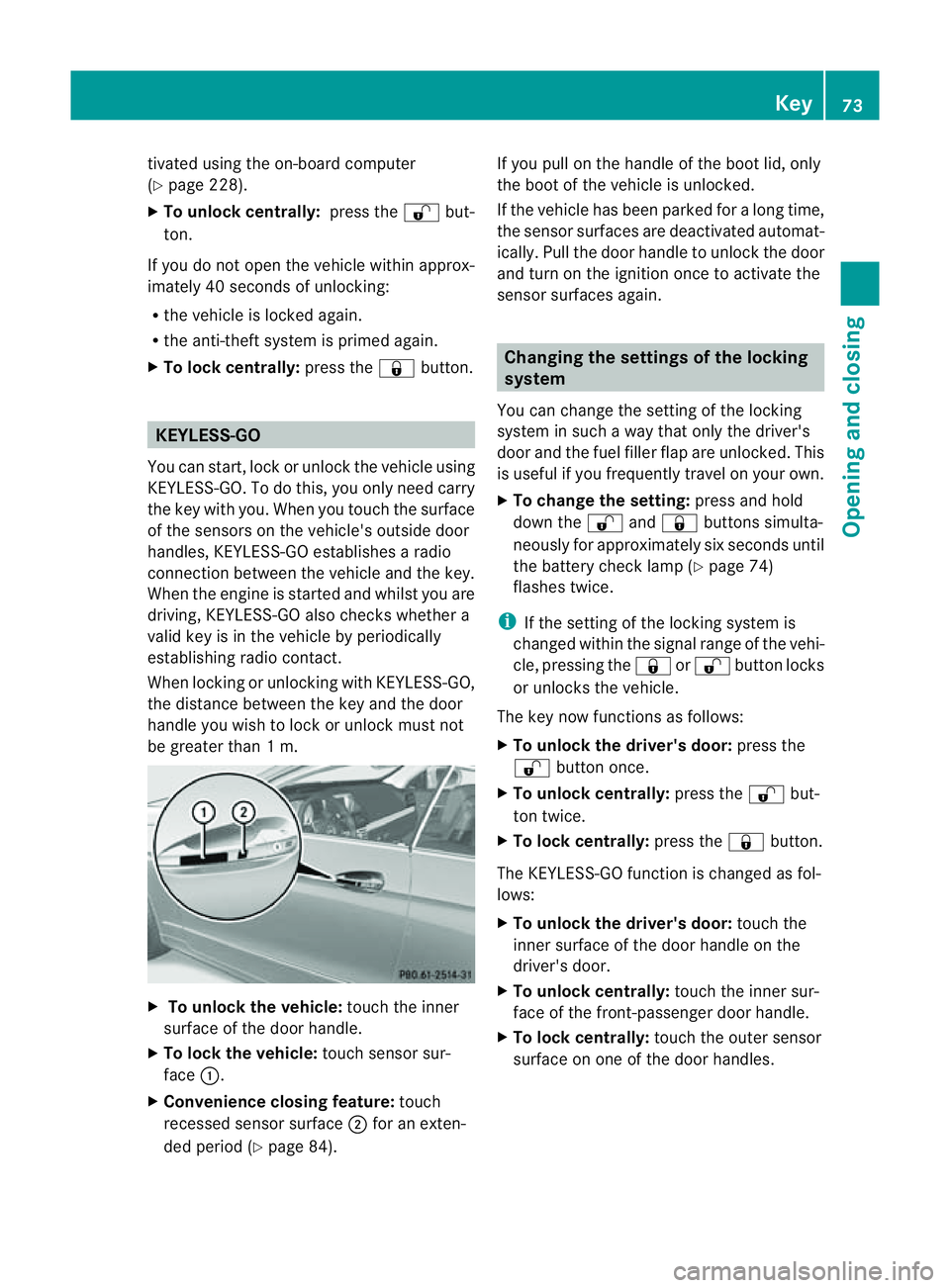
tivate
dusing the on-board computer
(Y page 228).
X To unloc kcentrally: pressthe % but-
ton.
If you do not open th evehicle within approx-
imately 40 seconds of unlocking:
R the vehicle is locked again.
R the anti-thef tsystem is primed again.
X To lock centrally: press the&button. KEYLESS-GO
You can start ,loc koru nlock the vehicl eusing
KEYLESS-GO .Todothis, you only need carry
the key with you. When you touch the surface
of the sensors on the vehicle's outside door
handles, KEYLESS-GO establishes aradio
connection between the vehicle and the key.
When the engine is started and whilst you are
driving, KEYLESS-GO also checksw hether a
valid key is in the vehicle by periodically
establishing radio contact.
When lockin gorunlockingw ith KEYLESS-GO,
the distanc ebetween the key and the door
handle you wish to lock or unloc kmust not
be greate rtha n1m. X
To unlock th evehicle: touch th einner
surface of th edoor handle.
X To lock th evehicle: touch sensor sur-
face :.
X Convenience closin gfeature: touch
recessed sensor surface ;for an exten-
ded period (Y page 84). If you pull on th
ehandle of th eboot lid, only
th eb oot of th evehicl eisu nlocked.
If th evehicl ehas been parked for alon gtime,
th es ensor surface sare deactivated automat-
ically. Pull th edoor handle to unlock th edoor
and tur nontheignition once to activat ethe
sensor surface sagain. Changing th
esettings of th elocking
system
You can chang ethe setting of th elocking
system in suc haway that only th edriver's
door and th efuel fille rflap are unlocked. This
is useful if you frequently travel on your own.
X To chang ethe setting: press and hold
down the %and& buttons simulta-
neously for approximately six seconds until
the battery chec klamp (Y page 74)
flashes twice.
i If the settin gofthe locking system is
changed within the signal rang eofthe vehi-
cle, pressing the &or% button locks
or unlocks the vehicle.
The key now functions as follows:
X To unlock th edriver' sdoor: press the
% button once.
X To unlock centrally: press the%but-
ton twice.
X To lock centrally: press the&button.
The KEYLESS-GO function is changed as fol-
lows:
X To unlock th edriver' sdoor: touchthe
inner surface of the door handle on the
driver's door.
X To unlock centrally: touchthe inner sur-
face of the front-passenger door handle.
X To lock centrally: touchthe outer sensor
surface on one of the door handles. Key
73Opening and closing Z
Page 80 of 353
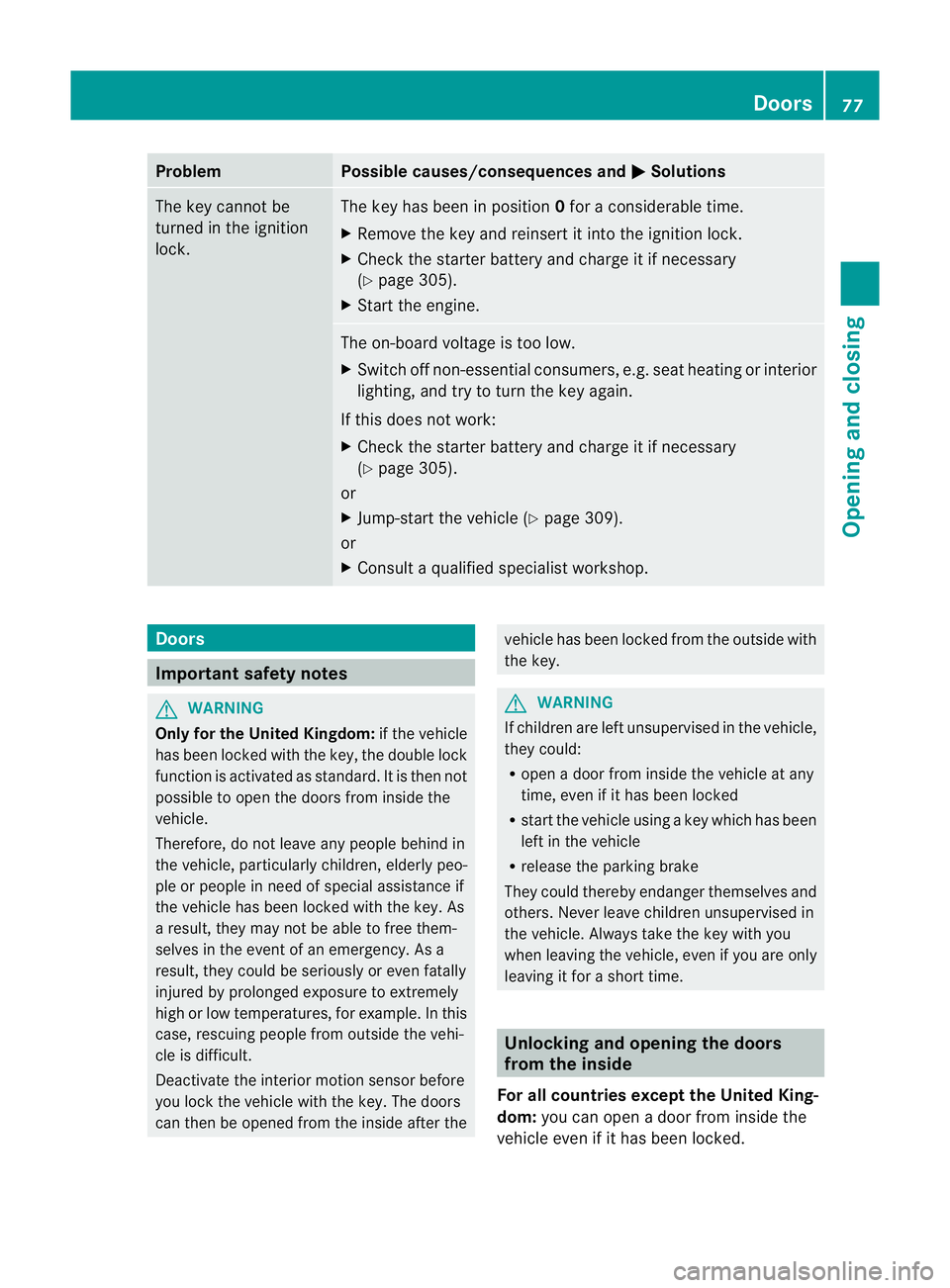
Problem Possible causes/consequences and
M Solutions
The key cannot be
turned in the ignition
lock. The key has been in position
0for aconsiderable time.
X Remove the key and reinsert it into the ignition lock.
X Check the starter battery and charge it if necessary
(Y page 305).
X Start the engine. The on-board voltage is too low.
X
Switch off non-essential consumers, e.g. seat heating or interior
lighting, and try to turn the key again.
If this does not work:
X Check the starter battery and charge it if necessary
(Y page 305).
or
X Jump-start the vehicle (Y page 309).
or
X Consult aqualified specialist workshop. Doors
Important safety notes
G
WARNING
Only for the United Kingdom: if the vehicle
has been locked with the key, the double lock
function is activated as standard. It is then not
possible to open the doors from inside the
vehicle.
Therefore, do not leave any people behind in
the vehicle, particularly children, elderly peo-
ple or people in need of special assistance if
the vehicle has been locked with the key. As
ar esult, they may not be able to free them-
selves in the event of an emergency. As a
result, they could be seriously or even fatally
injured by prolonged exposure to extremely
high or low temperatures, for example. In this
case, rescuing people from outside the vehi-
cle is difficult.
Deactivat ethe interior motion sensor before
you lock the vehicle with the key. The doors
can then be opened from the inside after the vehicle has been locked from the outside with
the key.
G
WARNING
If children are left unsupervised in the vehicle,
they could:
R open adoor from inside the vehicle at any
time, even if it has been locked
R start the vehicle using akey which has been
left in the vehicle
R release the parking brake
They could thereby endanger themselves and
others. Never leave children unsupervised in
the vehicle. Always take the key with you
when leaving the vehicle, even if you are only
leaving it for ashort time. Unlocking and opening the doors
from the inside
For all countries except the United King-
dom: you can open adoor from inside the
vehicle even if it has been locked. Doors
77Opening and closing Z
Page 82 of 353
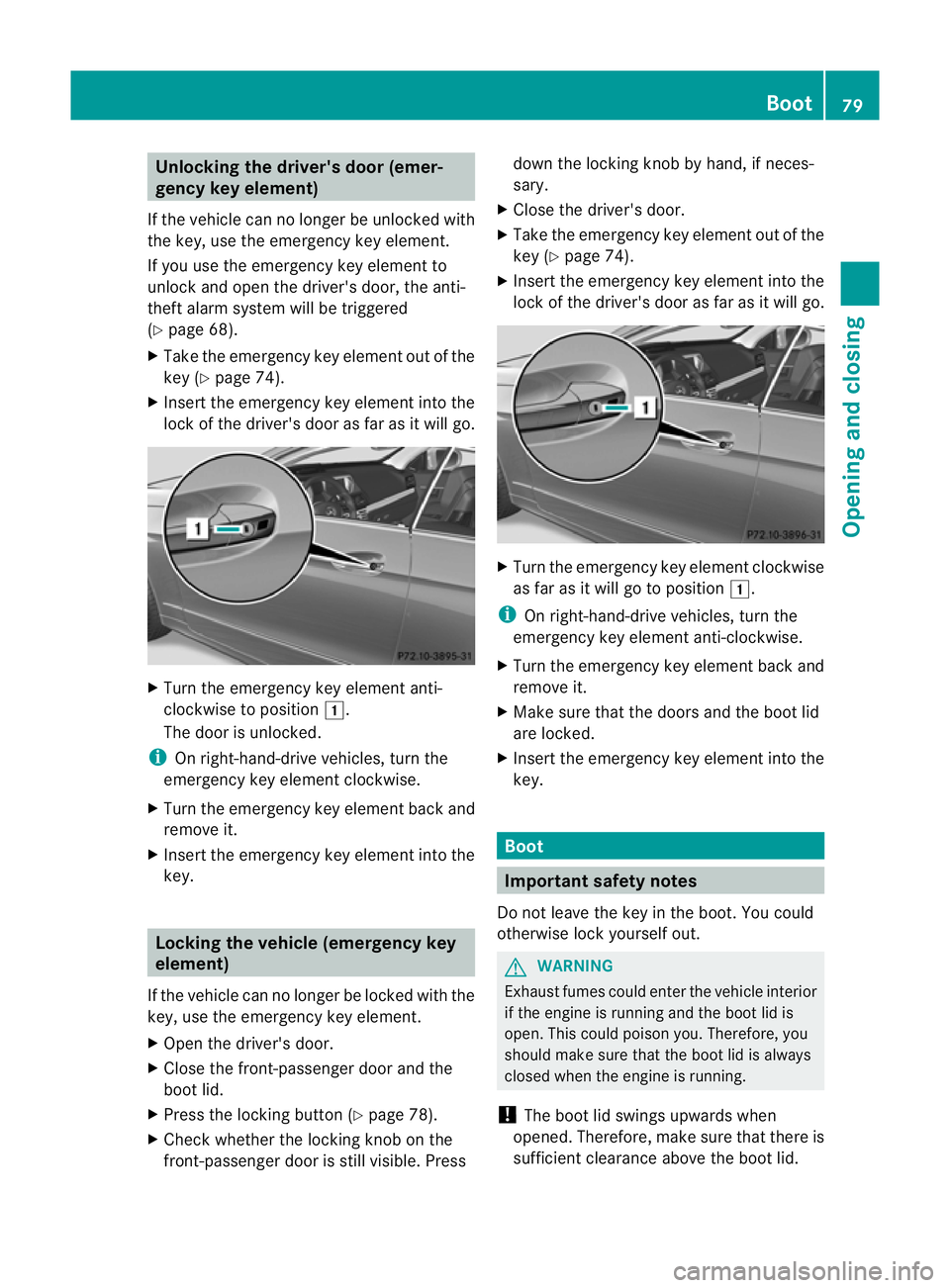
Unlocking the driver's door (emer-
gency key element)
If the vehicle can no longer be unlocked with
the key, use the emergency key element.
If you use the emergency key element to
unlock and open the driver' sdoor, the anti-
thef talarm system will be triggered
(Y page 68).
X Take the emergency key elemen tout of the
ke y( Ypage 74).
X Inser tthe emergency key element into the
lock of the driver's door as far as it will go. X
Turn the emergency key element anti-
clockwise to position 1.
The door is unlocked.
i On right-hand-drive vehicles, turn the
emergency key element clockwise.
X Turn the emergency key element back and
remove it.
X Insert the emergency key element into the
key. Locking the vehicle (emergency key
element)
If the vehicle can no longer be locked with the
key, use the emergency key element.
X Open the driver's door.
X Close the front-passenger door and the
boot lid.
X Press the locking button (Y page 78).
X Check whether the locking knob on the
front-passenger door is still visible. Press down the locking knob by hand, if neces-
sary.
X Close the driver's door.
X Take the emergency key element out of the
key (Y page 74).
X Insert the emergency key element into the
lock of the driver's door as far as it will go. X
Turn the emergency key element clockwise
as far as it will go to position 1.
i On right-hand-drive vehicles, turn the
emergency key element anti-clockwise.
X Turn the emergency key element back and
remove it.
X Make sure that the doors and the boot lid
are locked.
X Insert the emergency key element into the
key. Boot
Important safety notes
Do not leave the key in the boot. You could
otherwise lock yourself out. G
WARNING
Exhaust fumes could enter the vehicle interior
if the engine is running and the boot lid is
open. This could poison you. Therefore, you
should make sure that the boot lid is always
closed when the engine is running.
! The boot lid swings upwards when
opened. Therefore, make sure that there is
sufficient clearance above the boot lid. Boot
79Opening and closing Z
Page 124 of 353
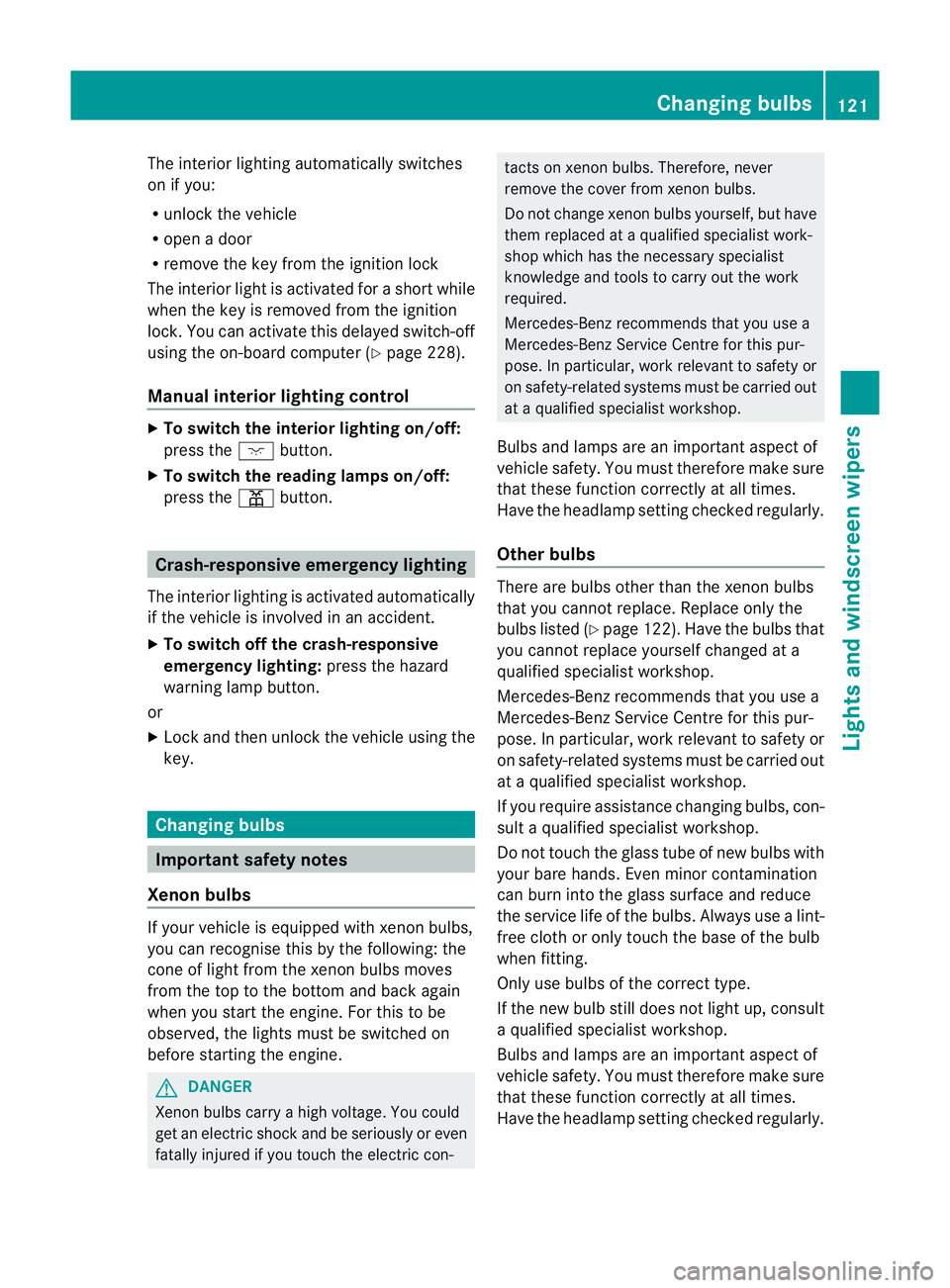
The interior lighting automatically switches
on if you:
R unlock the vehicle
R open adoor
R remove the key from the ignition lock
The interior light is activated for ashort while
when the key is removed from the ignition
lock. You can activat ethis delayed switch-off
using the on-board computer (Y page 228).
Manual interior lighting control X
To switch the interior lighting on/off:
press the cbutton.
X To switch the reading lamps on/off:
press the pbutton. Crash-responsive emergency lighting
The interior lighting is activated automatically
if the vehicle is involved in an accident.
X To switch off the crash-responsive
emergency lighting: press the hazard
warning lamp button.
or
X Lock and then unlock the vehicle using the
key. Changing bulbs
Important safety notes
Xenon bulbs If your vehicle is equipped with xenon bulbs,
you can recognise this by the following: the
cone of light from the xenon bulbs moves
from the top to the bottom and back again
when you start the engine. For this to be
observed, the lights must be switched on
before startingt he engine. G
DANGER
Xenon bulbs carry ahigh voltage. You could
get an electric shock and be seriously or even
fatally injured if you touch the electric con- tacts on xenon bulbs. Therefore, never
remove the cover from xenon bulbs.
Do not change xenon bulbs yourself, but have
them replaced at
aqualified specialist work-
shop which has the necessary specialist
knowledge and tools to carry out the work
required.
Mercedes-Ben zrecommends that you use a
Mercedes-Benz Service Centr efor this pur-
pose. In particular, work relevant to safety or
on safety-related systems must be carried out
at aq ualified specialist workshop.
Bulbs and lamps are an important aspect of
vehicle safety. You must therefore make sure
that these function correctly at all times.
Have the headlamp setting checked regularly.
Other bulbs There are bulbs other than the xenon bulbs
that you cannot replace. Replace only the
bulbs listed (Y
page 122). Have the bulbs that
you cannot replace yourself changed at a
qualified specialist workshop.
Mercedes-Benz recommends that you use a
Mercedes-Benz Service Centr efor this pur-
pose. In particular, work relevant to safety or
on safety-related systems must be carried out
at aq ualified specialist workshop.
If you require assistanc echangin gbulbs, con-
sult aqualified specialist workshop.
Do not touch the glass tube of new bulbs with
your bare hands. Even minor contamination
can burn into the glass surface and reduce
the servic elife of the bulbs. Always use alint-
free cloth or only touch the base of the bulb
when fitting.
Only use bulbs of the correct type.
If the new bulb still does not light up, consult
aq ualified specialist workshop.
Bulbs and lamps are an important aspect of
vehicle safety. You must therefore make sure
that these function correctly at all times.
Have the headlamp setting checked regularly. Changing bulbs
121Lights and windscreen wipers Z
Page 156 of 353
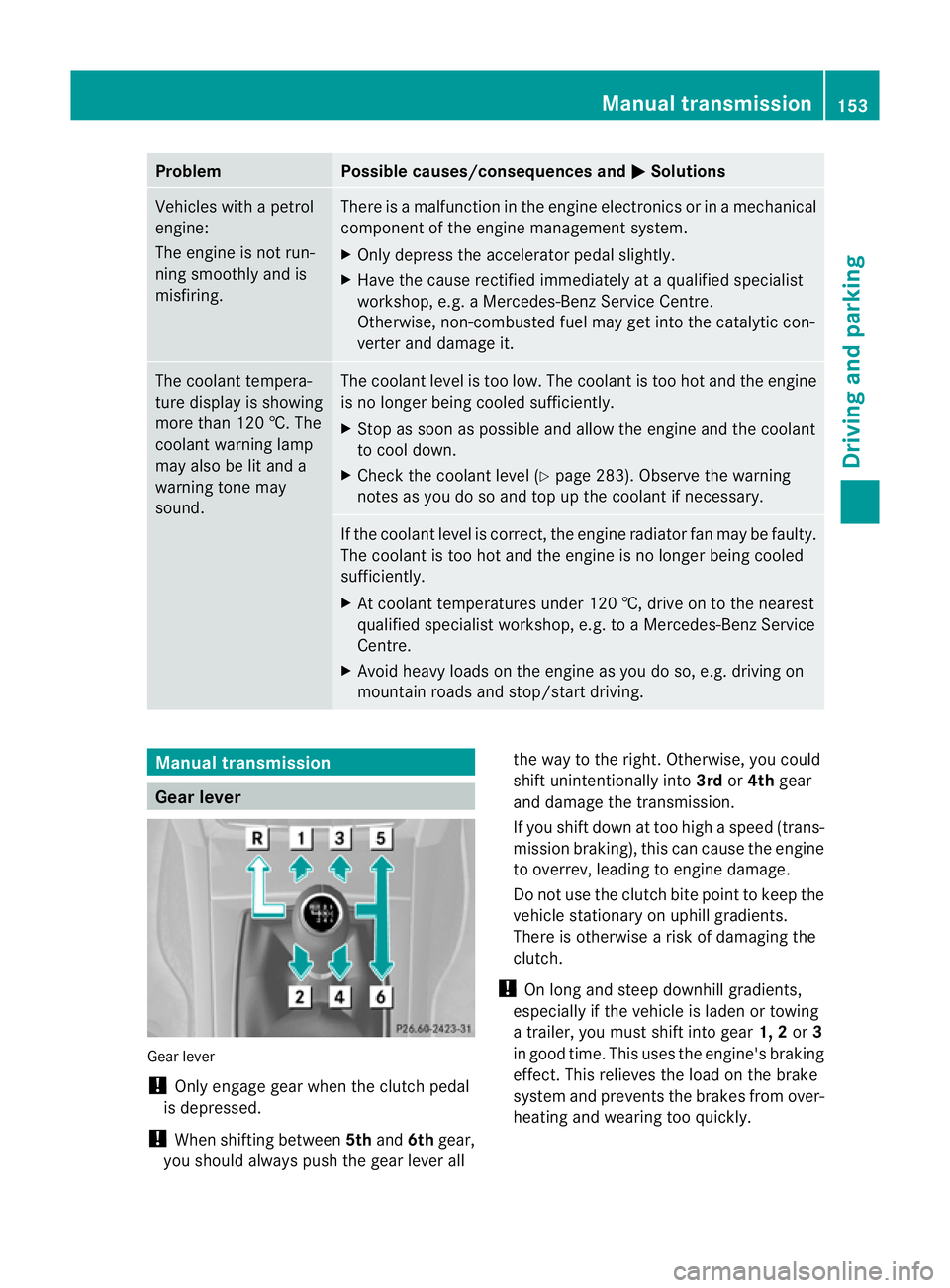
Problem Possible causes/consequences and
M Solutions
Vehicles with
apetrol
engine:
The engine is not run-
ning smoothly and is
misfiring. There is
amalfunction in the engine electronics or in amechanical
componentoft he engine management system.
X Only depress the accelerator pedal slightly.
X Have the cause rectified immediately at aqualified specialist
workshop, e.g. aMercedes-Benz Service Centre.
Otherwise, non-combusted fuel may get into the catalytic con-
verter and damage it. The coolant tempera-
ture display is showing
more than 120 †. The
coolant warning lamp
may also be lit and a
warning tone may
sound. The coolant level is too low. The coolant is too hot and the engine
is no longer being cooled sufficiently.
X
Stop as soon as possible and allow the engine and the coolant
to cool down.
X Check the coolant level (Y page 283). Observe the warning
notes as you do so and top up the coolant if necessary. If the coolant level is correct, the engine radiator fan may be faulty.
The coolant is too hot and the engine is no longer being cooled
sufficiently.
X
At coolant temperatures under 120 †, drive on to the nearest
qualified specialist workshop, e.g. to aMercedes-Benz Service
Centre.
X Avoid heavy loads on the engine as you do so, e.g. driving on
mountain roads and stop/start driving. Manual transmission
Gear lever
Gear lever
!
Only engage gear when the clutch pedal
is depressed.
! When shifting between 5thand 6thgear,
you should always push the gear lever all the way to the right. Otherwise, you could
shift unintentionally into
3rdor4th gear
and damage the transmission.
If you shift down at too high aspeed (trans-
mission braking), this can cause the engine
to overrev, leading to engine damage.
Do not use the clutch bite point to keep the
vehicle stationary on uphill gradients.
There is otherwise arisk of damaging the
clutch.
! On long and steep downhill gradients,
especially if the vehicle is laden or towing
at railer, you must shift into gear 1, 2or3
in good time. This uses the engine's braking
effect.T his relieves the load on the brake
system and prevents the brakes from over-
heating and wearing too quickly. Manual transmission
153Driving and parking Z